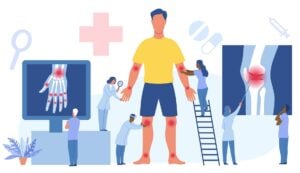

Complex regional pain syndrome (CRPS) is a devastating, multifactorial, painful condition that may develop in a limb following injury, trauma or surgery. The incidence rate is typically low, although it depends heavily on the type and location of injury or surgery.
Diagnosis of CRPS is based on patient history and symptom presentation according to the Budapest Criteria approved by the International Association for the Study of Pain (IASP). The diagnostic criteria require a patient to have continuing pain and a combination of signs and categories of symptoms:
There are two subtypes of CRPS, indicating whether the condition occurred without detectable nerve trauma (Type-1) or as a result of direct nerve injury (Type-2).
CRPS can also be described as “warm” or “cold”. Generally, acute CRPS is considered “warm”, characterised by increased temperature, red skin colour, sweating and swelling of the limb, while cases of chronic CRPS (≥12 months duration) are commonly considered “cold”, characterised by decreased temperature, pale or blueish skin colour and dystrophy (i.e. muscle or bone weakness).
The initiation and development of CRPS involves disturbances to multiple biological systems. The exact processes or mechanisms and how they interact to produce the disorder, however, is largely unknown. Some of the major proposed mechanisms or involved factors include unresolved tissue trauma and inflammation, microvascular dysfunction, abnormal pain processing and “sensitisation” (when the nerve(s) in the affected limb, and eventually also the central nervous system, becomes more sensitive to pain), sympathetic nervous system overactivity and immune system dysfunction.
Identifying the specific causes of CRPS is further complicated by individual patient variation in biological disturbances, as well as genetics and lifestyle factors. Furthermore, as CRPS progresses into the chronic phase, the underlying pathophysiology evolves, which is why the acute and chronic phases typically appear and feel so different.
Treatment of CRPS is difficult and depends heavily on the spectrum and duration of symptoms of the individual patient. Early intervention is crucial to maximising the success rate of resolving the condition. Chronic CRPS requires different therapies to acute CRPS and is more about managing the pain.
Typically, a series of treatment trials is necessary, and multimodal, multidisciplinary therapy is required.
Commonly prescribed oral medications include nonsteroidal anti-inflammatory drugs (NSAIDs; i.e. ibuprofen), tricyclic antidepressants (TCAs; i.e. amitriptyline), anticonvulsants (i.e. gabapentin), opioids and steroids. Analgesic medications are generally unhelpful.
Topical medications may be useful, especially in acute CRPS and in patients who are sensitive to medication side effects. These include topical NSAIDs, free-radical scavengers, TCAs, anaesthetics (i.e. ketamine), clonidine, and capsaicin (capsicum plant extract). These may be mixed to create a combination analgesic cream that aims to treat multiple symptoms.
It is important for CRPS patients to overcome fear of movement and to exercise the limb as motion stimulates cartilage nutrition and circulation to joints. This helps to decrease hypersensitivity and oedema and to restore mobility and normal function.
Motor imagery training (i.e. mirror box therapy, imagined movements and limb orientation recognition tasks) have been found to improve pain, oedema and limb function in acute and chronic cases of CRPS.
Due to the great emotional and psychological burden of chronic pain and CRPS symptoms, psychotherapy is essential. Patients are especially prone to developing depression and/or anxiety disorders. Cognitive behavioural therapy is recommended.
Given the involvement of the sympathetic nervous system and the stress response, relaxation skills and biofeedback are also useful.
Procedures that may be useful in treating CRPS include intravenous drug infusions (i.e. pamidronate and ketamine), sympathetic nerve blocks, nerve ablation (radiofrequency neurotomy) and transcutaneous electrical stimulation (TENS).
When conventional treatments fail, or the condition progresses into the chronic phase, more advanced, invasive therapies may be required, such as surgery (i.e. to correct peripheral nerve lesions) and implantable devices (i.e. stimulators and intrathecal pumps). Currently, spinal cord stimulation appears to be a more effective therapy for managing chronic CRPS than other options.
As researchers and clinicians continue to unravel the complex mechanisms that cause CRPS, the path to more effective treatments should open. The ultimate goal of research is to discover or develop drugs or therapies that can target key elements contributing to CRPS and thus stop CRPS in its tracks.
Genesis Research Services conducts clinical trials for a range of painful conditions. To view currently recruiting studies or register your interest for future studies, click here or call us on (02) 4985 1860.
View our currently recruiting studies:
Register your interest for future studies:
© Genesis Research Services, 2023